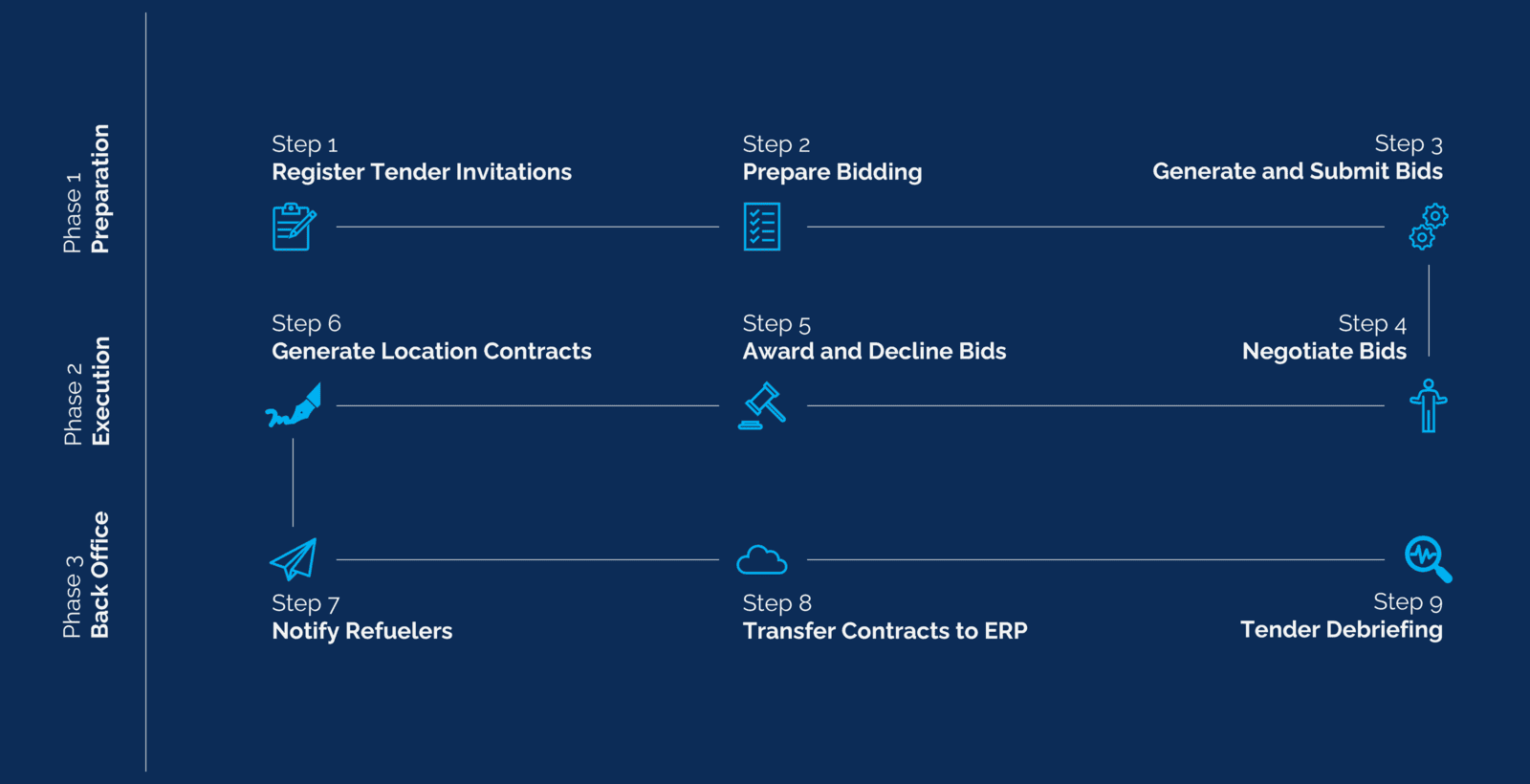Navigating the Next Leg of the Tender Journey - Execution and Back Office
In the first phase of the tender process, we tackled preparation —logging invitations, strategizing bids, and making sense of complex demands. But if you thought the journey was over, think again. The tender process is a marathon, not a sprint. Once bids are submitted, the real action begins.
Welcome to Phase 2: Execution and Phase 3: Back Office, where bids are negotiated, awarded, and transformed into actionable contracts. This part of the journey is where every decision, every data point, can make or break the outcome. Luckily, the Tender Workbench is here to guide you through these turbulent skies.

Phase 2: Execution - From Negotiation to Contract Creation
The bids are out, but now the real action begins. Negotiations, awards, and contracts—this is where strategy meets diplomacy.
Step 4: Bid Negotiation - The Art of the Counteroffer
You’ve submitted your bid, exhaled deeply, and maybe even celebrated a little. But don’t relax just yet. The client’s feedback is coming, and it’s going to test your agility. Expect ranking updates, competitor insights, and a slew of “small tweaks” that can feel more like major overhauls.
The Challenge: Managing multiple tender rounds with all their feedback manually is like flying without autopilot. You’re juggling spreadsheets, emails, and approvals while trying to stay aligned with the customer’s shifting expectations—and the clock is always ticking.
How the Tender Workbench helps:
- Built-in bid versioning keeps every update tracked, aligned, and approved.
- Feedback, whether it’s about rankings or pricing, is logged centrally for easy reference—and for that all-important debrief later.
- Revised bids are seamlessly approved and sent back, leaving you more time to focus on strategy and less on admin.
Step 5: Managing Bid Awards and Declines - Win, Learn, Repeat
Bids submitted, negotiations done—now it’s time to see where the chips fall. Will you secure that key airport contract? Or will another supplier edge you out? Whatever the outcome, every award or decline comes with valuable insights.
The Challenge: Keeping track of outcomes manually is a logistical headache. Which bids were awarded, which were declined, and why? Without clarity, follow-ups can stall, and future strategies miss the mark.
How the Tender Workbench helps:
- Automated Award and decline tracking ensures nothing gets lost in translation (or in a spreadsheet cell).
- Declines are recorded with reasons, competitor insights, and pricing details, giving you actionable intelligence.
- Awarded bids are prepped for internal approval, creating a seamless transition to the next step: contract generation.
Step 6: Generating and Executing Contracts—Turning Agreements into Action
Winning is great, but now comes the tricky part: turning those victories into legally binding contracts. Each contract is a mix of terms, pricing, and specific requirements that must be crystal-clear for both parties.
The Challenge: Without automation, contract creation can feel like deciphering an ancient manuscript. One typo, one misplaced clause, and you’re in for a long call with Legal.
How the Tender Workbench helps:
- Pre-defined templates turn awarded bids into ready-to-sign contracts in no time.
- Compliance workflows ensure every document meets internal and external requirements.
- E-signatures streamline execution, while final contracts are securely archived for future reference.
Phase 3: Back Office - The Tender Journey Doesn't End Here
The tender is awarded, the contracts are signed, and the champagne is (almost) popped. But the final phase is critical: ensuring flawless delivery and learning for the future.
Step 7: Notifying Into-Plane Service Providers—Clearing the Runway
The ink on the contract is barely dry, but your into-plane service providers need the details now. Fuel delivery is a game of precision, and any misstep here could derail your hard-won contract.
The Challenge: Without a clear, automated notification system, delays and miscommunications are almost inevitable.
How the Tender Workbench helps:
- Automatically generates fuel release authorizations, ensuring service providers know exactly what’s needed and when.
- Coordinates logistics with precision, aligning seamlessly with contract terms.
Step 8: Transferring Contracts to ERP Systems—The Digital Bridge
Contracts are only as good as their execution. For that, they need to be seamlessly integrated into your operational systems for planning, billing, and logistics.
The Challenge: Manual data entry is tedious and error-prone—a nightmare waiting to happen in a high-stakes industry.
How the Tender Workbench helps:
- Automatically transfers contract data to ERP systems, ensuring everything is synced and ready for action.
- Reduces billing delays and operational mismatches, giving you a head start on delivery.
Step 9: Generating Debriefing Reports—Learning for the Future
Every tender is a goldmine of insights—if you know where to look. What did you do right? Where did you stumble? What can you learn from the competition?
The Challenge: Manually compiling reports is time-consuming, and missing data points can skew your conclusions.
How the Tender Workbench helps:
- Automatically compiles comprehensive, customizable debriefing reports at the click of a button.
- Consolidates data from every step, from customer feedback to competitor analysis, to highlight strengths and pinpoint areas for improvement.
The Journey Doesn’t End—It Evolves

Ready to experience the benefits of the Tender Workbench? Contact us today for a demo and see how it can transform your tender management processes!